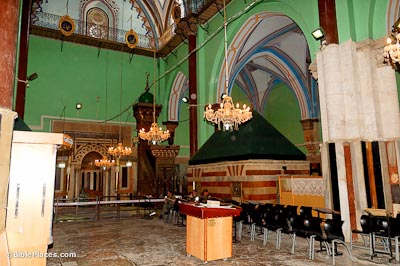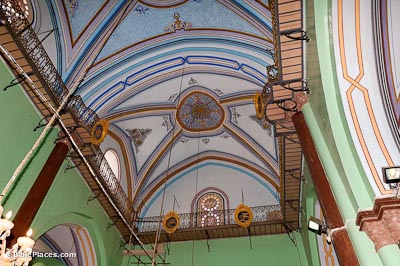Genesis 23 records the purchase by Abraham of a plot of ground in Hebron for a burial cave for his wife Sarah. In a deal that foreshadows many other Middle Eastern deals, Abraham paid an outrageous 400 shekels of silver to Ephron the Hittite. Later Abraham, Isaac, Rebekah, Jacob, and Leah would be buried here.
Hebron

The Machpelah
Herodian Construction
Herod the Great constructed a large edifice atop the traditional burial place of the patriarchs. Its architectural style is similar to that of Jerusalem’s Temple Mount, including the size of the stones (up to 24 feet [7 m] long), the type of masonry (dry), and the pilasters (engaged columns), the last of which are no longer visible in Jerusalem.


Machpelah Interior
The cenotaphs of Abraham and Sarah were added after the city moved to surround this complex in 8th century AD. All the cenotaphs were in their present position by the 10th century AD. The Mamluks gave the cenotaphs of Jacob and Leah their present form in the 14th century.
Cenotaph of Isaac
Three major rooms make up the Machpelah. In the center are Abraham and Sarah. On the east side are Isaac and Rebekah; the Jewish people are allowed to visit here only ten days a year. On the west side are the cenotaphs of Jacob and Leah. Rachel was buried near Bethlehem.
The pulpit (minbar) was made in 1091 for a mosque in Ashkelon and donated by Saladin in 1191.


Crusader Ceiling
Ownership of the Machpelah has changed with each conquering army. The Byzantines converted it into a church before the Muslims conquered and made it a mosque. The Crusaders and Mamluks then made it a church and a mosque again, respectively. The interior of the compound was originally not roofed; the ceiling is the work of Crusader artisans.

Download all of our Judah and the Dead Sea photos!
$39.00 $49.99 FREE SHIPPING
Related Websites
For historical images illustrating Abraham’s sojourn, see Life in the Holy Land.
Hebron (Into His Own) A brief, encyclopedia-type article with links to related words, topics and sources for further study.
Hebron (Jewish Virtual Library) An excellent article including specific sections on “History,” “Religious Significance,” and “Hebron Today.” A good introduction to the site.
Hebron: Historical Background and Statistics (PDF from the Israeli government) An interesting and informative article from 1996, providing a detailed historical background on the city and details of the Jewish community present there modernly. A section giving insight into the delicate peace-keeping process in the community is also included.
Tel Hebron Archaeological Park and Admot Ishay-Tel Rumeida Neighborhood (The Hebron Fund) A history accompanied by a video about Hebron and the archaeological park.
Welcome to Hevron (israelVisit) Offers a brief description of the Cave of Machpelah and the religious/political controversy surrounding it. Features several nice photographs on the main page and provided links.
Tomb of the Patriarchs and Matriarchs (Ma’arat HaMachpelah) (Jewish Virtual Library) A brief but helpful history.
Machpelah (Catholic Encyclopedia) A detailed, very descriptive article which discusses various contributions to traditions concerning of the Tomb of the Patriarchs.
Machpelah (ChristianAnswers.net) Interests the reader with both physically and biblically descriptive facts, including internal links to related topics.
Machpelah (Jewish Encyclopedia) A distinctly Jewish history of Machpelah.
Book excerpt (archive.org) For those interested, you can read a narrative about the Machpelah from an 1848 book, written by a Holy Land traveler who toured many sites known in biblical archaeology. The book was titled Early Travels in Palestine by Thomas Wright, and the account can be found on book page 86 (digital page 125), beginning a third of the way down the page with “Here is. . .”
Hebron: The Conflict in a Nutshell (Jerusalem Post) This 2017 article sums up the conflict in quite a detailed manner.
Jewish Settlers in Hebron Claim They Have History on Their Side (Sydney Morning Herald) This 2002 article provides interesting insight into the on-going conflict, commenting on security measures to protect the Jewish community in Hebron.